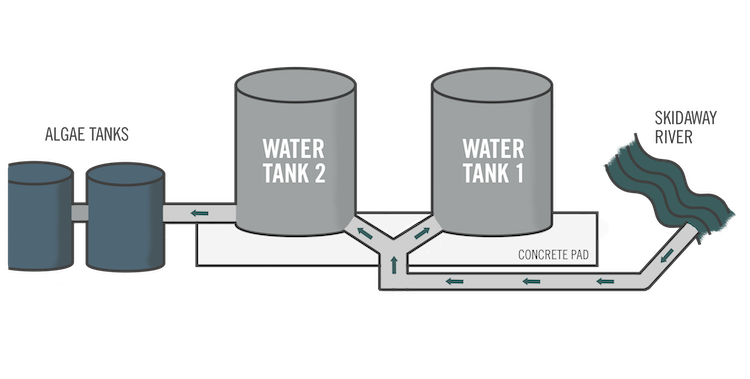The UGA Shellfish Research Lab can increase oyster production, as well as produce more algae to feed the baby oysters, thanks to new water tanks and a concrete pad to hold the tanks donated to Marine Extension and Georgia Sea Grant.
The 24 x 24-foot concrete water storage pad was donated by Peeples Industries, Inc., and poured next to the shellfish research facility at UGA Marine Extension and Georgia Sea Grant on Skidaway Island.

Water collected in the donated tanks will be used to grow algae in tanks outside the lab.
The pad holds three 10,000-gallon water tanks and a 2,000-gallon tank that were donated by the UGA Skidaway Institute of Oceanography, also on Skidaway Island.
With the new holding tanks, the Shellfish Research Lab can now bring in up to 10,000 gallons of water daily from the Skidaway River that will be used for the lab’s oyster hatchery. The water in the tanks will settle for 24 to 48 hours before being pumped into smaller tanks in the hatchery where larval algae and oyster seed are kept.
“In the water, we have a lot of fine particulate matter, such as different types of sediments and detritus,” said Tom Bliss, director of the Shellfish Research Lab. “Those tanks allow the water to sit very still and [the sediment] slowly settles down to the bottom, so it’s more efficient for us to do water changes.”
The tanks will also be used to supply water to the algae tanks, which play a crucial role in oyster growth. Extension specialists at the lab started growing algae three years ago to supplement store-bought and natural food used to feed the oysters. The new water tanks will allow the team to expand algae production and increase the amount of food available to the oysters.

Baby oysters in the hatchery rely on water brought in from the Skidaway River. The holding tanks will allow for increased oyster production in the hatchery.
According to Bliss, the tanks not only give them the flexibility to expand production by using more of their available resources, but they also act as a safety net should storms knock out the lab’s power. The tanks are able to supply almost a week’s worth of backup water supply in the event of a power outage.
Thanks to the donation, the concrete pad and new holding tanks were placed just in time for oyster spawning season, which will allow the lab to produce more oysters and algae this spring.

